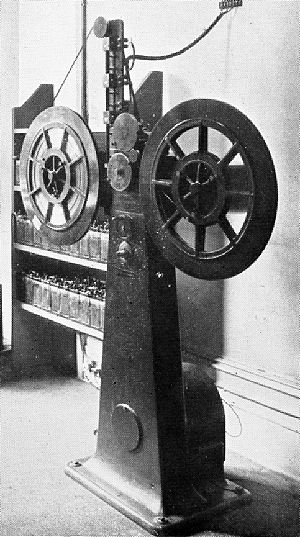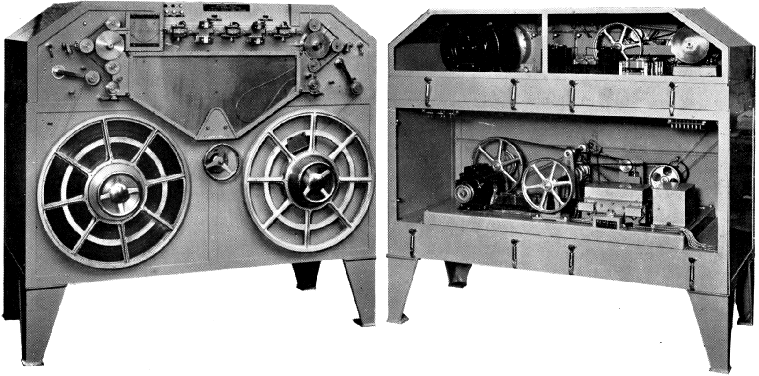

CONTENTS
1 INTRODUCTION
2 STEEL TAPE
3 OPTICAL FILM
4 DIRECTLY-CUT DISKS
5 MAGNETIC TAPE
6 PORTABLE RECORDING
7 CARTS AND DARTS
8 DIGITAL RECORDING AND PLAYOUT
Magnetic recording had been around since Valdemar Poulsen's 'Telegraphone' of 1899 - a wire recorder without amplification (the carbon microphone - as used in telephones - was connected directly to the recording head) which could just about drive headphones. However there were many technical difficulties, and it was not until the late 1920s that a moderately practicable magnetic recorder was developed in Germany.
 This was the Blatterphone (left), which used 6mm wide steel tape
travelling at 5 feet per second: the large reels allowed for 20
minutes
of continuous recording and, importantly for the BBC, once the
recording had been rewound it could be played back without
further
processing. The first machine was installed in 1930 and later
joined by
a second; in September 1932 a new version using 3mm wide tape
and
allowing for 30 minutes recording became available.
This was the Blatterphone (left), which used 6mm wide steel tape
travelling at 5 feet per second: the large reels allowed for 20
minutes
of continuous recording and, importantly for the BBC, once the
recording had been rewound it could be played back without
further
processing. The first machine was installed in 1930 and later
joined by
a second; in September 1932 a new version using 3mm wide tape
and
allowing for 30 minutes recording became available.
A major use for the machines was for the Empire Service, which started in 1932, and often required programmes to be broadcast in the middle of the night; the Blattnerphone allowed these to be recorded in advance. However there were many problems. The speed was unstable, the sound quality was hissy and lacking in top, and both the heads and the tape could break easily. Editing was possible, though this required either a soldering iron or a spot-welder and left an audible plop as the joint passed through, so it was rarely done.
Despite the problems, the machines proved useful, though the majority of broadcasts continued to be live. By 1935 a new machine had been developed, the Marconi-Stille, using the same principles but with advanced techniques to attempt to address the problems of the Blattnerphone.

The quality was slightly improved, though it still tended to be
obvious
that one was listening to a recording, as was the reliability. A
reservoir system containing a loop of tape (seen above the
right-hand
spool in the picture, above left) helped to stabilize the speed
(there
was also a smaller one just before the heads). The tape was 3mm
wide
and travelled at 1.5 metres/second. The
first one was installed at Maida Vale in March 1935 and by
September
there were three recording rooms, each with two machines.
They were hardly easy to handle. The spools were heavy (and expensive) and the tape has been described to me as being like a travelling razor blade: I was told that several people lost the tips of fingers through incautious handling. The tape was liable to snap, particularly at joints, which at that speed could rapidly cover the floor with loops of the sharp-edged tape. Rewinding was done at twice the speed of the recording: apparently on one occasion a reel came loose, bounced on the floor and went straight through a partition wall.
However despite all this the ability to make replayable recordings was extremely useful, and even with subsequent methods coming into use the Marconi-Stilles remained in use until the late 1940s.
From the mid 1930s two further methods slowly came into use: film and disc. The film recording process will be covered on the next page.
1 INTRODUCTION
2 STEEL TAPE
3 OPTICAL FILM
4 DIRECTLY-CUT DISKS
5 MAGNETIC TAPE
6 PORTABLE RECORDING
7 CARTS AND DARTS
8 DIGITAL RECORDING AND PLAYOUT

Magnetic recording had been around since Valdemar Poulsen's 'Telegraphone' of 1899 - a wire recorder without amplification (the carbon microphone - as used in telephones - was connected directly to the recording head) which could just about drive headphones. However there were many technical difficulties, and it was not until the late 1920s that a moderately practicable magnetic recorder was developed in Germany.
 This was the Blatterphone (left), which used 6mm wide steel tape
travelling at 5 feet per second: the large reels allowed for 20
minutes
of continuous recording and, importantly for the BBC, once the
recording had been rewound it could be played back without
further
processing. The first machine was installed in 1930 and later
joined by
a second; in September 1932 a new version using 3mm wide tape
and
allowing for 30 minutes recording became available.
This was the Blatterphone (left), which used 6mm wide steel tape
travelling at 5 feet per second: the large reels allowed for 20
minutes
of continuous recording and, importantly for the BBC, once the
recording had been rewound it could be played back without
further
processing. The first machine was installed in 1930 and later
joined by
a second; in September 1932 a new version using 3mm wide tape
and
allowing for 30 minutes recording became available.A major use for the machines was for the Empire Service, which started in 1932, and often required programmes to be broadcast in the middle of the night; the Blattnerphone allowed these to be recorded in advance. However there were many problems. The speed was unstable, the sound quality was hissy and lacking in top, and both the heads and the tape could break easily. Editing was possible, though this required either a soldering iron or a spot-welder and left an audible plop as the joint passed through, so it was rarely done.
Despite the problems, the machines proved useful, though the majority of broadcasts continued to be live. By 1935 a new machine had been developed, the Marconi-Stille, using the same principles but with advanced techniques to attempt to address the problems of the Blattnerphone.

They were hardly easy to handle. The spools were heavy (and expensive) and the tape has been described to me as being like a travelling razor blade: I was told that several people lost the tips of fingers through incautious handling. The tape was liable to snap, particularly at joints, which at that speed could rapidly cover the floor with loops of the sharp-edged tape. Rewinding was done at twice the speed of the recording: apparently on one occasion a reel came loose, bounced on the floor and went straight through a partition wall.
However despite all this the ability to make replayable recordings was extremely useful, and even with subsequent methods coming into use the Marconi-Stilles remained in use until the late 1940s.
From the mid 1930s two further methods slowly came into use: film and disc. The film recording process will be covered on the next page.



